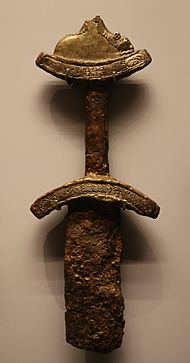Abingdon Sword facts for kids
The Abingdon Sword is a very old iron sword from the Anglo-Saxon period in England. It's believed to be from the late 800s or early 900s. Today, only the handle, called the hilt, and a small part of the blade remain.
This ancient sword was discovered in 1874 near a place called Bog Mill, close to the town of Abingdon in England. Abingdon is located on the River Thames. The sword is now kept safely at the Ashmolean Museum in Oxford.
The Abingdon Sword is special because of its beautiful decorations. Its handle has silver parts with a dark metal inlay called niello. This decoration is in a style known as the Trewhiddle style, which was popular during the Anglo-Saxon era. The sword's guard (the part between the blade and the handle) shows detailed patterns of animals woven together. It also features symbols representing the Four Evangelists, who were important figures in Christianity. The very top part of the handle, called the pommel, is decorated with two animal heads.
The way the guards and pommel are designed helps experts figure out the sword's age. These styles were common from the late 800s to the 900s.

You can see a copy of the Abingdon Sword at the Abingdon County Hall Museum. This reproduction has been on display there since the museum reopened in 2012.
What Does the Abingdon Sword Look Like?
The Abingdon Sword's upper and lower guards are curved. They have many detailed designs woven into them. These designs include birds, animals, human figures, and leaf patterns.
On the upper guard, some figures have been identified as the four symbols of the evangelists. The style of leaves next to the eagle figure on the upper guard is similar to designs found on embroideries from the early 900s. Other objects from this time, like the famous Alfred Jewel, also show similar artistic styles.
The pommel, at the top of the handle, has two animal heads facing outwards. These heads have ears that stick out and round eyes and nostrils. Some parts of these heads are now broken.
The Blade of the Sword
Most of the iron blade of the Abingdon Sword is missing. However, scientists have used X-rays to look at the remaining part. These X-rays show that the blade was made using a special technique called pattern welding. This method involved twisting and hammering different types of iron together to create a very strong and flexible blade with a unique pattern.
See also
- Abingdon Museum
- Abingdon Monks' Map


